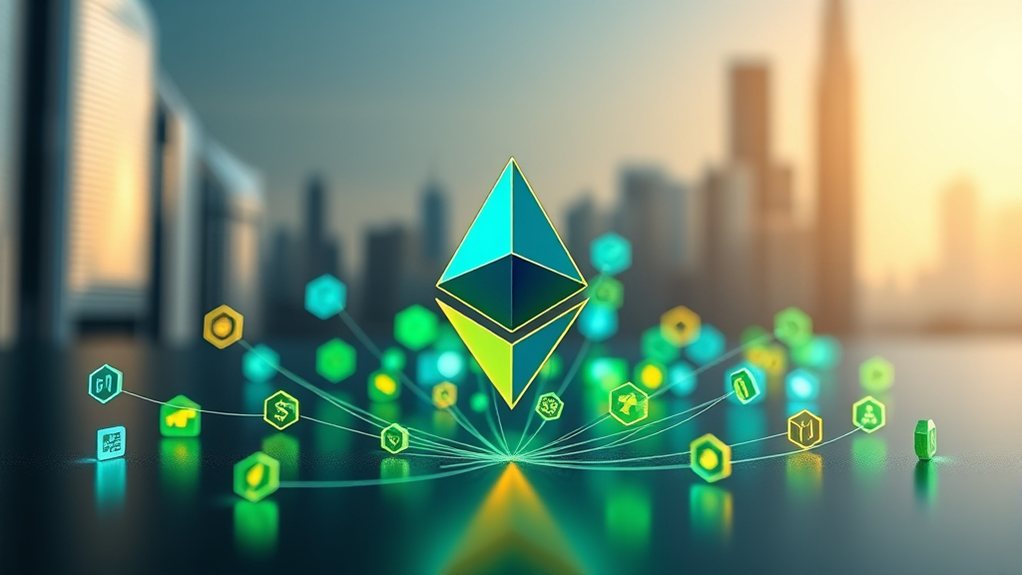ERC20 tokens are digital assets that run on the Ethereum blockchain. Created in 2017, they follow a standard set of rules that guarantees they work consistently across all Ethereum applications. These tokens require specific functions like transfer and balanceOf to operate properly. Popular examples include stablecoins like USDT and USDC. ERC20 tokens have simplified digital asset creation but require ETH for transaction fees. The standard's design reveals why it revolutionized cryptocurrency development.

While many people have heard of cryptocurrencies like Bitcoin, fewer are familiar with ERC20 tokens, which power much of the Ethereum blockchain ecosystem. ERC20 is a technical standard that was proposed in 2015 and officially adopted in 2017. It establishes specific rules and functions that tokens must follow to operate on the Ethereum network. This standard guarantees that all tokens created with it work consistently across the entire Ethereum system.
ERC20 tokens are fungible digital assets. This means each token is identical to every other token of the same type, similar to how one dollar bill holds the same value as any other dollar bill. The standard defines a set of common functions that developers must include when creating tokens. These functions allow the tokens to be transferred, tracked, and managed across the Ethereum blockchain. The standard was developed to solve interoperability issues that existed before its implementation.
All ERC20 tokens must include several required functions to be compliant with the standard. These include totalSupply), which shows how many tokens exist; balanceOf), which checks an account's token balance; transfer), which moves tokens between accounts; transferFrom), which allows approved third parties to transfer tokens; and approve), which grants permission for token withdrawals. These functions guarantee all ERC20 tokens work in a predictable way. The standard also requires two mandatory event emissions that provide transparency when tokens are transferred or approved.
Developers can also add optional functions to enhance their tokens. These include name(), symbol(), and decimals(), which provide basic information about the token. While not required for compliance, these features improve usability and are commonly implemented in most tokens. They help exchanges and wallets display token information correctly.
Many popular cryptocurrencies are ERC20 tokens. These include Tether (USDT) and USD Coin (USDC), stablecoins pegged to the US dollar; Chainlink (LINK), which powers oracle networks; and Dai (DAI), a decentralized stablecoin. Even Binance Coin (BNB) started as an ERC20 token before moving to its own blockchain. Unlike Solana (SOL) which operates on its own blockchain architecture, ERC20 tokens rely on the Ethereum network for processing transactions.
The ERC20 standard offers several advantages. It simplifies the token creation process, promotes compatibility across the Ethereum ecosystem, and makes it easier for exchanges to list new tokens. It's also played an important role in the growth of decentralized finance (DeFi) applications.
However, ERC20 tokens face limitations. Users can lose tokens by sending them to incorrect addresses. Transactions require Ethereum (ETH) for gas fees, and network congestion can lead to high costs. Smart contract bugs can create security vulnerabilities, and the standard lacks some advanced features found in newer token formats.
Despite these challenges, ERC20 remains the foundation for thousands of tokens and continues to drive innovation in the blockchain space.
Frequently Asked Questions
How Do ERC20 Tokens Differ From NFTS?
ERC20 tokens differ from NFTs in several key ways.
They're fungible, meaning each token has the same value as others of its type. Unlike NFTs, they don't have unique identifiers or metadata.
ERC20 tokens can be divided into smaller units and follow a different technical standard (ERC20 vs. ERC721).
They're primarily used as currencies or utility tokens, while NFTs represent ownership of unique items.
Can ERC20 Tokens Be Converted Back to Ethereum?
Yes, ERC20 tokens can be converted back to Ethereum.
Users can exchange these digital tokens for ETH through cryptocurrency exchanges like Binance or Coinbase. They can also use decentralized platforms such as Uniswap or token swap services like ChangeNOW.
The conversion rates depend on market conditions. All transactions require network fees paid in ETH.
The process is similar to exchanging one currency for another.
What Risks Are Associated With Investing in ERC20 Tokens?
Investing in ERC20 tokens comes with several risks.
Smart contract vulnerabilities can lead to fund losses through attacks or code bugs. The market shows high price volatility and vulnerability to manipulation schemes.
Regulatory uncertainty creates legal and tax complications across different countries.
Technical risks include private key loss, exchange hacks, and smart contract failures.
Network congestion on Ethereum often causes high transaction fees during busy periods.
How Are ERC20 Token Prices Determined?
ERC20 token prices are determined by market forces.
Supply and demand play the biggest role, with limited tokens often valued higher.
Project fundamentals, including team experience and partnerships, influence investor confidence.
Market sentiment shifts with crypto trends and news coverage.
Technical factors like trading patterns and exchange listings impact prices too.
Token utility and real-world adoption also affect how much people will pay for these digital assets.
Which Wallets Best Support ERC20 Token Management?
Several wallets excel at ERC20 token management.
MetaMask leads with over 30 million users and browser integration. MyEtherWallet offers direct blockchain interaction. Trust Wallet supports 160+ assets with its dApp browser.
For hardware options, Ledger Nano X handles 5,500+ coins while Trezor Model T provides touchscreen navigation.
Mobile users often choose Coinbase Wallet for exchange integration or Argent for its smart contract security features.










